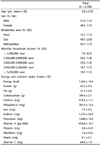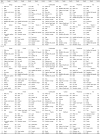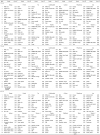1. Mikkilä V, Räsänen L, Raitakari OT, Pietinen P, Viikari J. Consistent dietary patterns identified from childhood to adulthood: the cardiovascular risk in Young Finns Study. Br J Nutr. 2005; 93:923–931.

2. Kobayashi T, Tanaka S, Toji C, Shinohara H, Kamimura M, Okamoto N, Imai S, Fukui M, Date C. Development of a food frequency questionnaire to estimate habitual dietary intake in Japanese children. Nutr J. 2010; 9:17.

3. Taillie LS, Afeiche MC, Eldridge AL, Popkin BM. The contribution of at-home and away-from-home food to dietary intake among 2-13-year-old Mexican children. Public Health Nutr. 2017; 20:2559–2568.

4. Huysentruyt K, Laire D, Van Avondt T, De Schepper J, Vandenplas Y. Energy and macronutrient intakes and adherence to dietary guidelines of infants and toddlers in Belgium. Eur J Nutr. 2016; 55:1595–1604.

5. Goldbohm RA, Rubingh CM, Lanting CI, Joosten KF. Food consumption and nutrient intake by children aged 10 to 48 months attending day care in the Netherlands. Nutrients. 2016; 8:428.

6. Satheannoppakao W, Kasemsup R, Nontarak J, Kessomboon P, Putwatana P, Taneepanichskul S, Sangthong R, Chariyalertsak S, Aekplakorn W. Energy and macronutrient intakes and food sources in preschool children: Thai NHES IV. J Med Assoc Thai. 2015; 98:957–967.
7. Grimes CA, Szymlek-Gay EA, Campbell KJ, Nicklas TA. Food sources of total energy and nutrients among U.S. infants and toddlers: National Health and Nutrition Examination Survey 2005-2012. Nutrients. 2015; 7:6797–6836.

8. Wang H, Denney L, Zheng Y, Vinyes-Pares G, Reidy K, Wang P, Zhang Y. Food sources of energy and nutrients in the diets of infants and toddlers in urban areas of China, based on one 24-hour dietary recall. BMC Nutr. 2015; 1:19.

9. Denney L, Afeiche MC, Eldridge AL, Villalpando-Carrión S. Food sources of energy and nutrients in infants, toddlers, and young children from the Mexican National Health and Nutrition Survey 2012. Nutrients. 2017; 9:494.

10. Neufingerl N, Djuwita R, Otten-Hofman A, Nurdiani R, Garczarek U, Sulaeman A, Zock PL, Eilander A. Intake of essential fatty acids in Indonesian children: secondary analysis of data from a nationally representative survey. Br J Nutr. 2016; 115:687–693.

11. Bautista LE, Herrán OF, Pryer JA. Development and simulated validation of a food-frequency questionnaire for the Colombian population. Public Health Nutr. 2005; 8:181–188.

12. Neelakantan N, Whitton C, Seah S, Koh H, Rebello SA, Lim JY, Chen S, Chan MF, Chew L, van Dam RM. Development of a semiquantitative food frequency questionnaire to assess the dietary intake of a multi-ethnic urban Asian population. Nutrients. 2016; 8:528.

13. Pérez-Rodrigo C, Artiach Escauriaza B, Artiach Escauriaza J, Polanco Allúe I. Dietary assessment in children and adolescents: issues and recommendations. Nutr Hosp. 2015; 31:Suppl 3. 76–83.
14. Livingstone MB, Robson PJ, Wallace JM. Issues in dietary intake assessment of children and adolescents. Br J Nutr. 2004; 92:Suppl 2. S213–S222.

15. Mubarik F, Bhaskaran K, Kho S, Vereijken C, Nambiar S, Eussen S, Muhardi L. Development of food lists as a first step to develop a food frequency questionnaire for toddlers in a multi-ethnic population. Nutr Diet. 2017; 74:11–17.

16. Kong A, Odoms-Young AM, Schiffer LA, Berbaum ML, Porter SJ, Blumstein L, Fitzgibbon ML. Racial/ethnic differences in dietary intake among WIC families prior to food package revisions. J Nutr Educ Behav. 2013; 45:39–46.

17. Kweon S, Kim Y, Jang MJ, Kim Y, Kim K, Choi S, Chun C, Khang YH, Oh K. Data resource profile: the Korea National Health and Nutrition Examination Survey (KNHANES). Int J Epidemiol. 2014; 43:69–77.

18. National Institute of Agricultural Sciences. Food Composition Table. 7th ed. Suwon: Rural Development Administration;2006.
19. Korea Centers for Disease Control and Prevention. Korea Health Statistics 2016: Korea National Health and Nutrition Examination Survey (KNHANES VII-1). Sejong: Ministry of Health and Welfare;2017.
20. Huybrechts I, Lin Y, De Keyzer W, Sioen I, Mouratidou T, Moreno LA, Slimani N, Jenab M, Vandevijvere S, De Backer G, De Henauw S. Dietary sources and sociodemographic and economic factors affecting vitamin D and calcium intakes in Flemish preschoolers. Eur J Clin Nutr. 2011; 65:1039–1047.

21. Huybrechts I, De Keyzer W, Lin Y, Vandevijvere S, Vereecken C, Van Oyen H, Tilleman K, Bellemans M, De Maeyer M, De Backer G, De Henauw S. Food sources and correlates of sodium and potassium intakes in Flemish pre-school children. Public Health Nutr. 2012; 15:1039–1046.

22. O'Halloran SA, Grimes CA, Lacy KE, Campbell KJ, Nowson CA. Dietary intake and sources of potassium and the relationship to dietary sodium in a sample of Australian pre-school children. Nutrients. 2016; 8:496.
23. O'Halloran SA, Grimes CA, Lacy KE, Nowson CA, Campbell KJ. Dietary sources and sodium intake in a sample of Australian preschool children. BMJ Open. 2016; 6:e008698.
24. Irish Universities Nutrition Alliance. National Pre-School Nutrition Survey -Summary Report. Cork: Irish Universities Nutrition Alliance;2012.
25. Joyce T, Wallace AJ, McCarthy SN, Gibney MJ. Intakes of total fat, saturated, monounsaturated and polyunsaturated fatty acids in Irish children, teenagers and adults. Public Health Nutr. 2009; 12:156–165.

26. Vyncke KE, Libuda L, De Vriendt T, Moreno LA, Van Winckel M, Manios Y, Gottrand F, Molnar D, Vanaelst B, Sjöström M, González-Gross M, Censi L, Widhalm K, Michels N, Gilbert CC, Xatzis C, Cuenca García M, de Heredia FP, De Henauw S, Huybrechts I. HELENA consortium. Dietary fatty acid intake, its food sources and determinants in European adolescents: the HELENA (healthy lifestyle in Europe by nutrition in adolescence) study. Br J Nutr. 2012; 108:2261–2273.

27. Sahoo K, Sahoo B, Choudhury AK, Sofi NY, Kumar R, Bhadoria AS. Childhood obesity: causes and consequences. J Family Med Prim Care. 2015; 4:187–192.

28. Kim J, Kim YJ, Ahn YO, Paik HY, Ahn Y, Tokudome Y, Hamajima N, Inoue M, Tajima K. Contribution of specific foods to fat, fatty acids, and cholesterol in the development of a food frequency questionnaire in Koreans. Asia Pac J Clin Nutr. 2004; 13:265–272.








 PDF
PDF ePub
ePub Citation
Citation Print
Print






 XML Download
XML Download